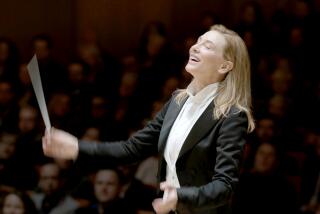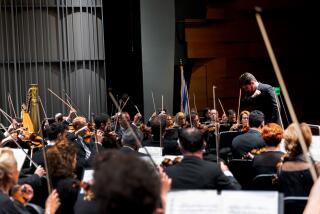A VINTAGE BACH TRIBUTE
Among the several tributes thus far to the tercentenaries of the births of Bach and Handel, the most extensive is a collection from Teldec (the erstwhile Telefunken) comprising 15 two-disc sets, 10 devoted to Bachâs music, five to Handelâs.
All have been available previously and are thus issued at a gratifyingly low price. Represented are the earliest and most successful of Nikolaus Harnoncourtâs scholarly efforts with his period-instrument ensemble, the Concentus Musicus of Vienna.
The recordings date from the 1960s, when Harnoncourt was still a âdirectorâ--leading, seated of course, from his cello position, rather than as wielder of the baton, an instrument known to drive men mad with power and, even worse, ideas.
Among the finest of these performances, dating from the infancy of the Baroque-authenticity movement, is a well-balanced, lively account of Bachâs B-minor Mass (Volume 3), with adult female, rather than boy soprano and alto soloists, that has weathered the years gracefully.
The Overtures, or Suites (Volume 8), are engaging despite the occasional laggard tempo; but the âBrandenburgâ Concertos (Volume 7) remain tentative efforts, the instrumentalists struggling so hard with their primitive instruments that what emerges is little more than the barest bones of the music. Here, in spite of Harnoncourtâs justly appreciated trail-blazing, his efforts have been superseded by interpretations of greater virtuosity and scholarly insight, e.g., those of the English Concert and English Baroque Soloists led, respectively, by Trevor Pinnock and John Eliot Gardiner.
The package devoted to six Violin Concertos (Volume 10) continues to provide rewarding listening, with Alice Harnoncourt the stylish principal soloist. On the other hand, the Harpsichord Concertos (Volume 9), in which Gustav Leonhardt carries the solo burden while also leading a small instrumental ensemble, sound painfully rigid by todayâs standards of execution and scholarship--notwithstanding the fact that several of the players who have since surpassed Leonhardtâs efforts were at one time his pupils.
Herbert Tachezi, otherwise the vivacious harpsichord continuo player of Concentus Musicus, takes the solo spotlight with an engrossing, imaginatively ornamented account--on the organ--of the usually forbidding âArt of the Fugueâ (Volume 1).
Impressive as the contents of volumes 4, 5 and 6--14 major cantatas--may have been on first encounter, much of the work of Harnoncourt and his colleagues now sounds technically labored and stylistically unimaginative. The members of Concentus Musicus--the brass in particular--struggle manfully but none too successfully with their recalcitrant instruments, sometimes having to be accommodated by unbecomingly slow tempos, and a lack of forceful leadership.
Then, too, there is the problem of the soprano and alto soloists, drawn from the ranks of the Vienna and Tolz boys choirs. Yes, yes, those are the sorts of voices for which Bach wrote, but one neednât--and this listener certainly doesnât--enjoy this particular element of antiquarian authenticity.
The other major component of the Bach collection, the âSt. Johnâ Passion (Volume 2), is straightforward and often quite moving. The playing of the Concentus maintains a generally high level, with tenor Kurt Equiluz a strong, unaffected Evangelist and bass Max van Egmondâs Jesus a figure of immense dignity and humanity.
But, again, there are those hooty boys, acceptable as chorus members but overmatched by the technical and emotional demands of the solos.
The Handel volumes find in Harnoncourt an eccentric, unsympathetic interpreter of the Concerti Grossi, âWater Musicâ and the magnificent ode, âAlexanderâs Feast.â Nor is there justification for the resuscitation of Karl Richterâs--he is both soloist and conductor of a modern-instruments orchestra--numbingly literal, heavyhanded and style-less accounts of the Opus 4 and Opus 7 Organ Concertos when there are surpassingly stylish and lively ones by Tachezi and, yes, Harnoncourt in the Teldec catalogue.
Best among the Handels is a generous selection of sonatas for recorder and various other instruments (Volume 2). Recorder virtuoso and father figure Frans Brueggen plays with verve and infinite skill in collaboration with several Concentus Musicus principals, including the ever compelling Tachezi at the harpsichord.
Outstanding among recent Bach from other sources is a vital and scholarly (the two elements were once mutually exclusive) set of âBrandenburgâ Concertos in which Ton Koopman directs his antique-instrument group, the Amsterdam Baroque Orchestra (Erato NUM 751342).
Granted, yet another issue of this most frequently recorded of Baroque music hardly fills a yawning gap in the catalogue. But to anyone who does not as yet own this music in period performance, the present version, with its high energy level and blazing virtuosity, is most enthusiastically recommended.
Virtuosity and energy are also prominent characteristics of a Bach program featuring Itzhak Perlman as soloist and conducting members of the Israel Philharmonic (Angel DS-37971). But here, in the Violin Concertos in D minor and G minor and the Concerto in C minor for violin and oboe--all arrangements of keyboard concertos by hands other than Bachâs-- the perspective is anachronistically Romantic.
The solo work, by Perlman and oboist Ray Still, is overly vibratoed, the phrasing bloated. Of Baroque style there isnât a trace, with the questionable exception of a barely audible harpsichord continuo.
More to Read
The biggest entertainment stories
Get our big stories about Hollywood, film, television, music, arts, culture and more right in your inbox as soon as they publish.
You may occasionally receive promotional content from the Los Angeles Times.










